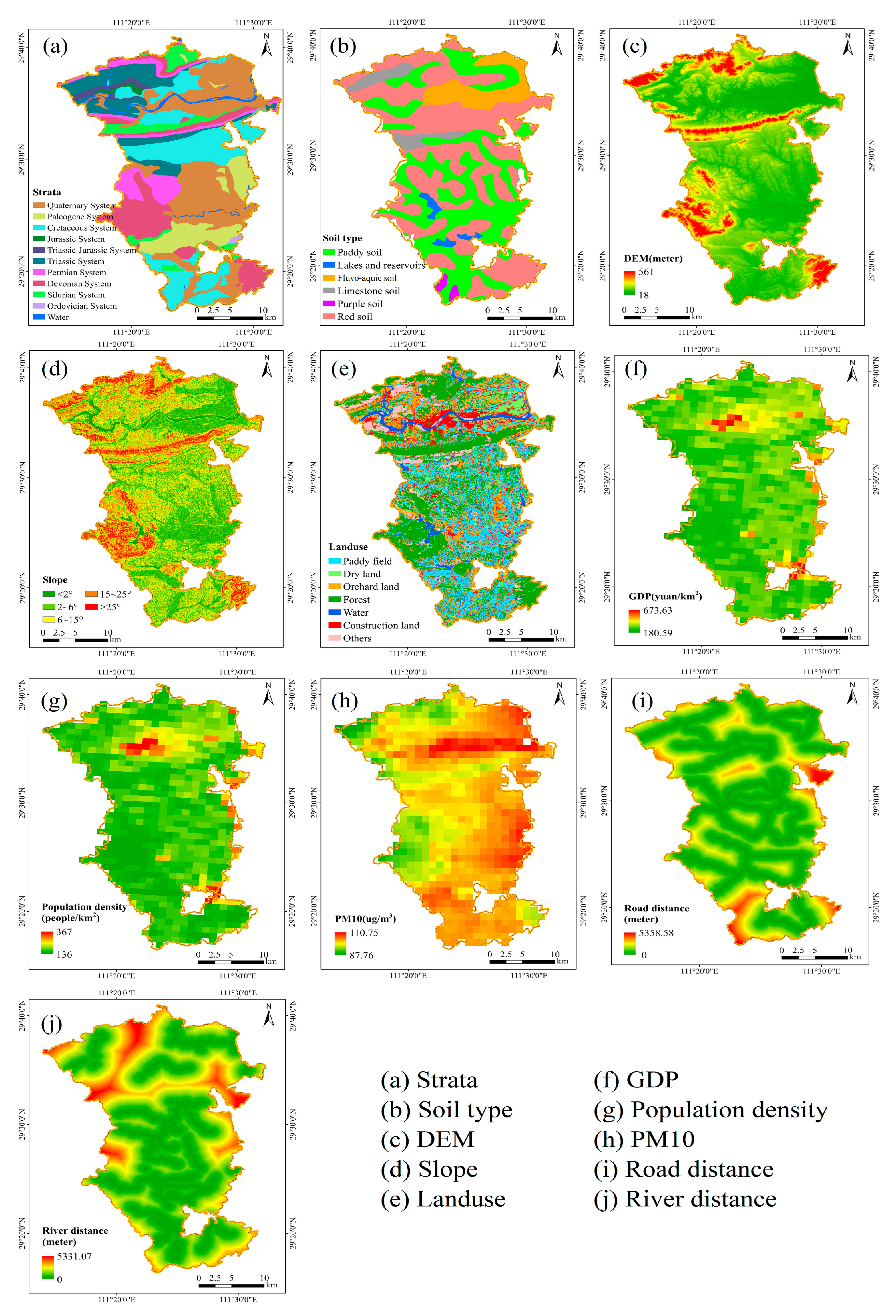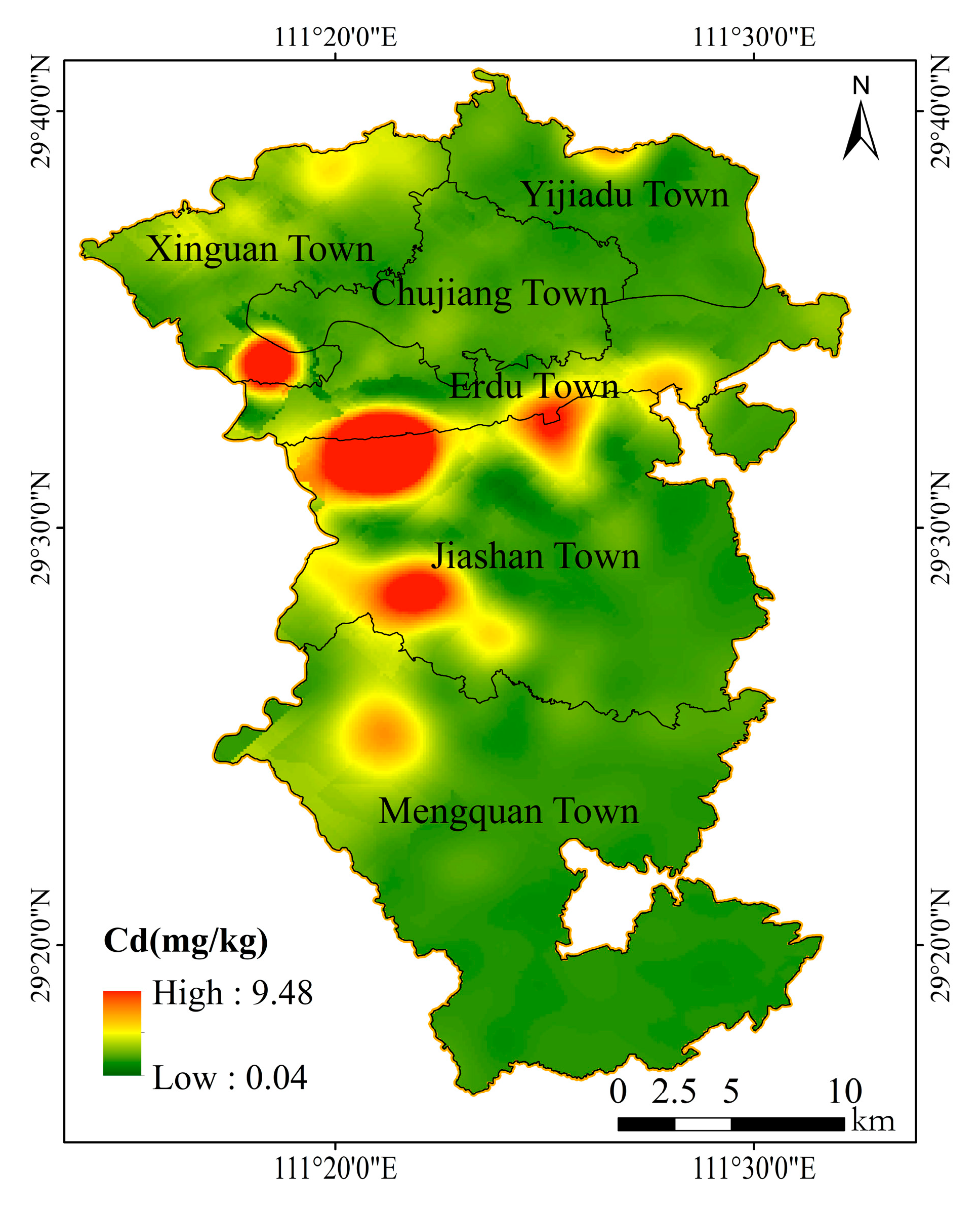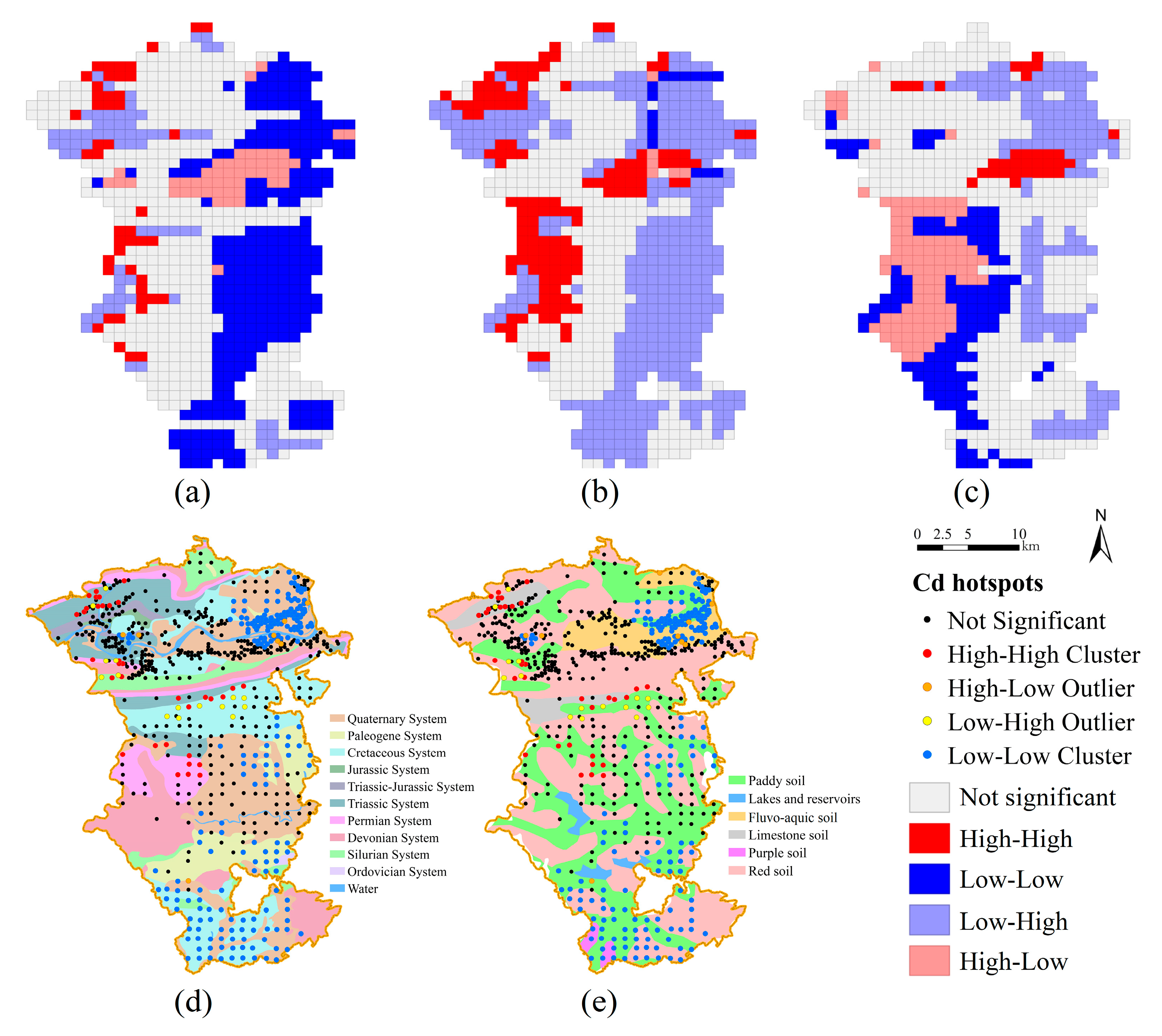Revealing Influencing Mechanisms and Spatial Pattern of Soil Cadmium Through Geodetector and Spatial Analysis
Abstract
1. Introduction
2. Materials and Methods
2.1. Study Area, Sampling, and Chemical Analysis
2.2. Potential Driving Factors
- (1)
- Strata
- (2)
- Soil type
- (3)
- Digital Elevation model (DEM)
- (4)
- Slope
- (5)
- Landuse type
- (6)
- Gross Domestic Product (GDP)
- (7)
- Population density
- (8)
- Atmospheric deposition
- (9)
- Road distance
- (10)
- River distance
2.3. Methods
2.3.1. Geodetector
2.3.2. Ordinary Kriging (OK)
2.3.3. Bivariate Local Indicators of Spatial Association
2.4. Data Source and Processing
3. Results and Discussion
3.1. Detection of Driving Factors by Geodetector Model
3.2. Spatial Distribution of Cd Concentration
3.3. Spatial Association Between Cd Concentrations and Driving Factors
3.4. Main Driving Factors That Influence Soil Cd Concentration
3.5. Limitations and Perspective
4. Conclusions
Author Contributions
Funding
Data Availability Statement
Conflicts of Interest
References
- Liu, J.; Kang, H.; Tao, W.; Li, H.; He, D.; Ma, L.; Tang, H.; Wu, S.; Yang, K.; Li, X. A spatial distribution—Principal component analysis (SD-PCA) model to assess pollution of heavy metals in soil. Sci. Total Environ. 2023, 859, 160112. [Google Scholar] [CrossRef]
- Yu, X.; Feng, W.; Song, F.; Han, Y.; Miao, Q.; Goncalves, J.M. Characterisation of heavy metals and microbial communities in urban river sediments: Interactions and pollution origin analysis. Environ. Res. 2025, 280, 121925. [Google Scholar] [CrossRef]
- Zang, Z.; Liu, S.; Li, Y. Spatial distribution of cadmium and lead in wheat grains and their environmental driving factors in major grain-producing areas, China. Ecol. Indic. 2025, 175, 113589. [Google Scholar] [CrossRef]
- Cao, H.; Liu, J.; Deng, P.; Beiyuan, J.; Li, L.; Wei, X.; Du, Z.; Chen, Y.; Lai, J.; Wang, J. Chromium accumulation in rice cultivated by distinctive chromium contaminated soils: The effects of geochemical speciation and microbial community. Environ. Pollut. 2025, 370, 125847. [Google Scholar] [CrossRef] [PubMed]
- Khan, S.; Cao, Q.; Zheng, Y.M.; Huang, Y.Z.; Zhu, Y.G. Health risks of heavy metals in contaminated soils and food crops irrigated with wastewater in Beijing, China. Environ. Pollut. 2008, 152, 686–692. [Google Scholar] [CrossRef]
- Sun, Y.; Yang, J.; Li, K.; Gong, J.; Gao, J.; Wang, Z.; Cai, Y.; Zhao, K.; Hu, S.; Fu, Y.; et al. Differentiating environmental scenarios to establish geochemical baseline values for heavy metals in soil: A case study of Hainan Island, China. Sci. Total Environ. 2023, 898, 165634. [Google Scholar] [CrossRef] [PubMed]
- Liang, N.; Zhang, C.; Zhang, Y.; Jiang, N.; Yang, J.; Geng, N.; Zhang, R.; Zhang, H.; Chen, J. Pollution levels, distribution characteristics and risk assessment of heavy metals (HMs) in road dust in major cities of China. J. Hazard. Mater. 2025, 494, 138733. [Google Scholar] [CrossRef]
- Feng, W.; Guo, Z.; Xiao, X.; Peng, C.; Shi, L.; Ran, H.; Xu, W. Atmospheric deposition as a source of cadmium and lead to soil-rice system and associated risk assessment. Ecotoxicol. Environ. Saf. 2019, 180, 160–167. [Google Scholar] [CrossRef]
- Duan, X.; Zhang, G.; Rong, L.; Fang, H.; He, D.; Feng, D. Spatial distribution and environmental factors of catchment-scale soil heavy metal contamination in the dry-hot valley of Upper Red River in southwestern China. Catena 2015, 135, 59–69. [Google Scholar] [CrossRef]
- Qiao, P.; Dong, N.; Yang, S.; Gou, Y. Quantitative analysis of the main sources of pollutants in the soils around key areas based on the positive matrix factorization method. Environ. Pollut. 2021, 273, 116518. [Google Scholar] [CrossRef]
- Zhao, L.; Yan, Y.; Yu, R.; Hu, G.; Cheng, Y.; Huang, H. Source apportionment and health risks of the bioavailable and residual fractions of heavy metals in the park soils in a coastal city of China using a receptor model combined with Pb isotopes. Catena 2020, 194, 104736. [Google Scholar] [CrossRef]
- Cai, L.-M.; Wang, Q.-S.; Wen, H.-H.; Luo, J.; Wang, S. Heavy metals in agricultural soils from a typical township in Guangdong Province, China: Occurrences and spatial distribution. Ecotoxicol. Environ. Saf. 2019, 168, 184–191. [Google Scholar] [CrossRef] [PubMed]
- Ma, Y.; Li, Y.; Fang, T.; He, Y.; Wang, J.; Liu, X.; Wang, Z.; Guo, G. Analysis of driving factors of spatial distribution of heavy metals in soil of non-ferrous metal smelting sites: Screening the geodetector calculation results combined with correlation analysis. J. Hazard. Mater. 2023, 445, 130614. [Google Scholar] [CrossRef] [PubMed]
- Yang, J.; Wang, J.; Qiao, P.; Zheng, Y.; Yang, J.; Chen, T.; Lei, M.; Wan, X.; Zhou, X. Identifying factors that influence soil heavy metals by using categorical regression analysis: A case study in Beijing, China. Front. Environ. Sci. Eng. 2020, 14, 37. [Google Scholar] [CrossRef]
- Wang, J.; Xu, C. Geodetector: Principle and prospective. Acta Geogr. Sin. 2017, 72, 116–134. [Google Scholar]
- Zeng, W.; Wan, X.; Wang, L.; Lei, M.; Chen, T.; Gu, G. Apportionment and location of heavy metal(loid)s pollution sources for soil and dust using the combination of principal component analysis, Geodetector, and multiple linear regression of distance. J. Hazard. Mater. 2022, 438, 129468. [Google Scholar]
- Sun, Y.Q.; Lei, S.G.; Zhao, Y.B.; Wei, C.; Yang, X.C.; Han, X.T.; Li, Y.Y.; Xia, J.N.; Cai, Z. Spatial distribution prediction of soil heavy metals based on sparse sampling and multi-source environmental data. J. Hazard. Mater. 2024, 465, 133114. [Google Scholar]
- Xie, Y.F.; Chen, T.B.; Lei, M.; Yang, J.; Guo, Q.J.; Song, B.; Zhou, X.Y. Spatial distribution of soil heavy metal pollution estimated by different interpolation methods: Accuracy and uncertainty analysis. Chemosphere 2011, 82, 468–476. [Google Scholar] [CrossRef]
- Liu, G.; Zhou, X.; Li, Q.; Shi, Y.; Guo, G.L.; Zhao, L.; Wang, J.; Su, Y.Q.; Zhang, C. Spatial distribution prediction of soil As in a large-scale arsenic slag contaminated site based on an integrated model and multi-source environmental data. Environ. Pollut. 2020, 267, 115631. [Google Scholar]
- Liu, Q.Y.; Zhao, W.H.; Ma, J.; Zhou, Y.Z.; Wu, Y.H.; Qu, Y.J.; Sun, Y. Spatial clustering and source-specific risk of combined pollutants in soils from an industrial area in Shanxi Province, China. Environ. Pollut. 2022, 299, 118925. [Google Scholar] [CrossRef]
- Huang, G.X.; Wang, X.H.; Chen, D.; Wang, Y.P.; Zhu, S.X.; Zhang, T.; Liao, L.; Tian, Z.; Wei, N. A hybrid data-driven framework for diagnosing contributing factors for soil heavy metal contaminations using machine learning and spatial clustering analysis. J. Hazard. Mater. 2022, 437, 129324. [Google Scholar] [CrossRef] [PubMed]
- Moore, J.A.; Kimsey, M.J.; Garrison-Johnston, M.; Shaw, T.M.; Mika, P.; Poolakkal, J. Geologic Soil Parent Material Influence on Forest Surface Soil Chemical Characteristics in the Inland Northwest, USA. Forests 2022, 13, 1363. [Google Scholar] [CrossRef]
- Zinn, Y.L.; de Faria, J.A.; de Araujo, M.A.; Araujo Skorupa, A.L. Soil parent material is the main control on heavy metal concentrations in tropical highlands of Brazil. Catena 2020, 185, 104319. [Google Scholar] [CrossRef]
- Zhong, X.; Chen, Z.; Li, Y.; Ding, K.; Liu, W.; Liu, Y.; Yuan, Y.; Zhang, M.; Baker, A.J.M.; Yang, W.; et al. Factors influencing heavy metal availability and risk assessment of soils at typical metal mines in Eastern China. J. Hazard. Mater. 2020, 400, 123289. [Google Scholar] [CrossRef] [PubMed]
- Xu, J.; Xiao, P. Influence factor analysis of soil heavy metal based on categorical regression. Int. J. Environ. Sci. Technol. 2022, 19, 7373–7386. [Google Scholar] [CrossRef]
- Jyoti, V.; Saini-Eidukat, B.; Hopkins, D.; DeSutter, T. Naturally elevated metal contents of soils in northeastern North Dakota, USA, with a focus on cadmium. J. Soils Sediments 2015, 15, 1571–1583. [Google Scholar] [CrossRef] [PubMed]
- Wang, S.Y.; Xiong, Z.A.; Han, X.X.; Wang, L.Q.; Liang, T. Unveiling the spatial differentiation drivers of major soil element behavior along traffic network accessibility. Environ. Pollut. 2024, 342, 123045. [Google Scholar]
- Ding, Q.; Cheng, G.; Wang, Y.; Zhuang, D. Effects of natural factors on the spatial distribution of heavy metals in soils surrounding mining regions. Sci. Total Environ. 2017, 578, 577–585. [Google Scholar]
- Qin, G.; Niu, Z.; Yu, J.; Li, Z.; Ma, J.; Xiang, P. Soil heavy metal pollution and food safety in China: Effects, sources and removing technology. Chemosphere 2021, 267, 129205. [Google Scholar] [CrossRef]
- Wang, X.; Sun, Y.; Zhang, L.; Mei, Y. Spatial variation and influence factor analysis of soil heavy metal As based on geoDetector. Stoch. Environ. Res. Risk Assess. 2021, 35, 2021–2030. [Google Scholar] [CrossRef]
- Chen, W.D.; Cai, Y.K.; Zhu, K.; Wei, J.; Lu, Y.T. Spatial heterogeneity analysis and source identification of heavy metals in soil: A case study of Chongqing, Southwest China. Chem. Biol. Technol. Agric. 2022, 9, 50. [Google Scholar] [CrossRef]
- Wang, M.; Zhang, H. Accumulation of Heavy Metals in Roadside Soil in Urban Area and the Related Impacting Factors. Int. J. Environ. Res. Public Health 2018, 15, 1064. [Google Scholar] [CrossRef] [PubMed]
- Wang, L.X.; Yan, B.X.; Zhu, L.L.; Ou, Y. The effect of reclamation on the distribution of heavy metals in saline-sodic soil of Songnen Plain, China. Environ. Earth Sci. 2015, 73, 1083–1090. [Google Scholar]
- Song, X.Y.; Sun, Y.; Wang, H.J.; Huang, X.M.; Han, Z.L.; Shu, Y.L.; Wu, J.H.; Zhang, Z.L.; Zhong, Q.C.; Li, R.X.; et al. Uncovering soil heavy metal pollution hotspots and influencing mechanisms through machine learning and spatial analysis. Environ. Pollut. 2025, 370, 125901. [Google Scholar] [CrossRef] [PubMed]
- Zhou, R.; Chen, J.; Cui, S.W.; Li, L.; Qian, J.B.; Zhao, H.; Huang, G.X. A data-driven framework to identify influencing factors for soil heavy metal contaminations using random forest and bivariate local Moran’s I: A case study. J. Environ. Manag. 2025, 375, 124172. [Google Scholar]
- Huang, S.; Xiao, L.; Zhang, Y.; Wang, L.; Tang, L. Interactive effects of natural and anthropogenic factors on heterogenetic accumulations of heavy metals in surface soils through geodetector analysis. Sci. Total Environ. 2021, 789, 147937. [Google Scholar] [PubMed]
- Tao, H.; Liao, X.; Li, Y.; Xu, C.; Zhu, G.; Cassidy, D.P. Quantifying in fluences of interacting anthropogenic-natural factors on trace element accumulation and pollution risk in karst soil. Sci. Total Environ. 2020, 721, 137770. [Google Scholar]
- Chang, Y.H.; Scrimshaw, M.D.; Emmerson, R.; Lester, J.N. Geostatistical analysis of sampling uncertainty at the Tollesbury Managed Retreat site in Blackwater Estuary, Essex, UK: Kriging and cokriging approach to minimise sampling density. Sci. Total Environ. 1998, 221, 43–57. [Google Scholar]
- Tang, Y.Y.; Zhang, D.H.; Xu, H.G.; Dai, L.L.; Xu, Q.Y.; Zhang, Z.J.; Jing, X.D. The role of topography feedbacks in enrichment of heavy metal elements in terrace type region. Front. Environ. Sci. 2024, 12, 1291917. [Google Scholar] [CrossRef]
- Chen, L.F.; Cai, X.Y.; Cao, M.X.; Liu, H.W.; Liang, Y.; Hu, L.G.; Yin, Y.G.; Li, Y.B.; Shi, J.B. Long-term investigation of heavy metal variations in mollusks along the Chinese Bohai Sea. Ecotoxicol. Environ. Saf. 2022, 236, 113443. [Google Scholar] [CrossRef]
- Chen, M.Z.; Li, X.X.; Cao, X.X.; Yang, W.T.; Wu, P.; Hao, H.Y.; Fei, Z.J.; Gao, Y.N. Soil-forming accumulation of heavy metals in geological high background areas: Constraints of structure, lithology, and overlying soil geochemistry. J. Geochem. Explor. 2024, 263, 107518. [Google Scholar] [CrossRef]
- Jiang, C.; Zhou, W.; Yang, L.; Yan, J.; Tu, S.; Yuan, Y.; Wang, D.; Cheng, H. Geochemical relationship and profile distribution of Selenium and Cadmium in typical Selenium-enriched areas in Enshi. Chemosphere 2023, 338, 139423. [Google Scholar] [CrossRef]
- Wen, Y.; Li, W.; Yang, Z.; Zhang, Q.; Ji, J. Enrichment and source identification of Cd and other heavy metals in soils with high geochemical background in the karst region, Southwestern China. Chemosphere 2020, 245, 125620. [Google Scholar] [CrossRef]
- Quezada-Hinojosa, R.P.; Matera, V.; Adatte, T.; Rambeau, C.; Foellmi, K.B. Cadmium distribution in soils covering Jurassic oolitic limestone with high Cd contents in the Swiss Jura. Geoderma 2009, 150, 287–301. [Google Scholar] [CrossRef]
- Ali, W.; Mao, K.; Zhang, H.; Junaid, M.; Xu, N.; Rasool, A.; Feng, X.; Yang, Z. Comprehensive review of the basic chemical behaviours, sources, processes, and endpoints of trace element contamination in paddy soil-rice systems in rice-growing countries. J. Hazard. Mater. 2020, 397, 122720. [Google Scholar] [CrossRef]
- Zou, M.; Zhou, S.; Zhou, Y.; Jia, Z.; Guo, T.; Wang, J. Cadmium pollution of soil-rice ecosystems in rice cultivation dominated regions in China: A review. Environ. Pollut. 2021, 280, 116965. [Google Scholar] [CrossRef]
- Ihedioha, J.N.; Ogili, E.O.; Ekere, N.R.; Ezeofor, C.C. Risk assessment of heavy metal contamination of paddy soil and rice (Oryza sativa) from Abakaliki, Nigeria. Environ. Monit. Assess. 2019, 191, 350. [Google Scholar] [CrossRef] [PubMed]
- Peng, H.; Chen, Y.; Weng, L.; Ma, J.; Ma, Y.; Li, Y.; Islam, M.S. Comparisons of heavy metal input inventory in agricultural soils in North and South China: A review. Sci. Total Environ. 2019, 660, 776–786. [Google Scholar] [CrossRef] [PubMed]
- Hu, W.; Wang, H.; Dong, L.; Huang, B.; Borggaard, O.K.; Hansen, H.C.B.; He, Y.; Holm, P.E. Source identification of heavy metals in peri-urban agricultural soils of southeast China: An integrated approach. Environ. Pollut. 2018, 237, 650–661. [Google Scholar] [CrossRef]
- Ni, R.; Ma, Y. Current inventory and changes of the input/output balance of trace elements in farmland across China. PLoS ONE 2018, 13, e0199460. [Google Scholar] [CrossRef] [PubMed]
- Tang, L.-l.; Fu, B.-m.; Wu, Y.; Cai, F.-c.; Ma, Y.-b. Linking atmospheric emission and deposition to accumulation of soil cadmium in the Middle-Lower Yangtze Plain, China. J. Integr. Agric. 2023, 22, 3170–3181. [Google Scholar] [CrossRef]
- Yu, P.Y.; Shao, X.Y.; Wang, M.D.; Zhu, Z.; Tong, Z.L.; Peng, J.W.; Deng, Y.C.; Huang, Y. Effects of atmospheric deposition on heavy metal contamination in paddy field systems under different functional areas in ChangZhuTan, Hunan Province, China. Sci. Total Environ. 2024, 933, 172953. [Google Scholar] [CrossRef] [PubMed]
- Mu, Y.; Cui, J.X.; Liu, A.D.; Wang, S.; Shi, Q.J.; Wang, J.; Wei, S.Q.; Zhang, J.Z. Interactions and quantification of multiple influencing factors on cadmium accumulation in soil-rice systems at a large region. Sci. Total Environ. 2023, 881, 163392. [Google Scholar] [CrossRef] [PubMed]
- Yang, Q.Q.; Li, Z.Y.; Lu, X.N.; Duan, Q.N.; Huang, L.; Bi, J. A review of soil heavy metal pollution from industrial and agricultural regions in China: Pollution and risk assessment. Sci. Total Environ. 2018, 642, 690–700. [Google Scholar] [CrossRef]
- Men, C.; Liu, R.M.; Xu, L.B.; Wang, Q.R.; Guo, L.J.; Miao, Y.X.; Shen, Z.Y. Source-specific ecological risk analysis and critical source identification of heavy metals in road dust in Beijing, China. J. Hazard. Mater. 2020, 388, 121763. [Google Scholar] [CrossRef]
- Zhao, M.L.; Wang, H.J.; Sun, J.X.; Tang, R.; Cai, B.Y.; Song, X.Y.; Huang, X.M.; Huang, J.; Fan, Z.Q. Spatio-temporal characteristics of soil Cd pollution and its influencing factors: A Geographically and temporally weighted regression (GTWR) method. J. Hazard. Mater. 2023, 446, 130613. [Google Scholar] [CrossRef] [PubMed]
- Feng, Y.X.; Yu, X.Z.; Zhang, H. A modelling study of a buffer zone in abating heavy metal contamination from a gold mine of Hainan Province in nearby agricultural area. J. Environ. Manag. 2021, 287, 112299. [Google Scholar] [CrossRef]
- Yang, Y.; Chen, W.; Wang, M.; Peng, C. Regional accumulation characteristics of cadmium in vegetables: Influencing factors, transfer model and indication of soil threshold content. Environ. Pollut. 2016, 219, 1036–1043. [Google Scholar] [CrossRef]
- Song, Y.; Wang, J.; Ge, Y.; Xu, C. An optimal parameters-based geographical detector model enhances geographic characteristics of explanatory variables for spatial heterogeneity analysis: Cases with different types of spatial data. Giscience Remote Sens. 2020, 57, 593–610. [Google Scholar] [CrossRef]








Disclaimer/Publisher’s Note: The statements, opinions and data contained in all publications are solely those of the individual author(s) and contributor(s) and not of MDPI and/or the editor(s). MDPI and/or the editor(s) disclaim responsibility for any injury to people or property resulting from any ideas, methods, instructions or products referred to in the content. |
© 2025 by the authors. Licensee MDPI, Basel, Switzerland. This article is an open access article distributed under the terms and conditions of the Creative Commons Attribution (CC BY) license (https://creativecommons.org/licenses/by/4.0/).
Share and Cite
Wang, J.; Yang, J.; Zhao, C.; Tian, X.; Zhao, X.; Zhao, W.; Xin, H.; Li, X. Revealing Influencing Mechanisms and Spatial Pattern of Soil Cadmium Through Geodetector and Spatial Analysis. Land 2025, 14, 1975. https://doi.org/10.3390/land14101975
Wang J, Yang J, Zhao C, Tian X, Zhao X, Zhao W, Xin H, Li X. Revealing Influencing Mechanisms and Spatial Pattern of Soil Cadmium Through Geodetector and Spatial Analysis. Land. 2025; 14(10):1975. https://doi.org/10.3390/land14101975
Chicago/Turabian StyleWang, Jingyun, Jun Yang, Chen Zhao, Xinglei Tian, Xiaofeng Zhao, Wei Zhao, Hao Xin, and Xianjun Li. 2025. "Revealing Influencing Mechanisms and Spatial Pattern of Soil Cadmium Through Geodetector and Spatial Analysis" Land 14, no. 10: 1975. https://doi.org/10.3390/land14101975
APA StyleWang, J., Yang, J., Zhao, C., Tian, X., Zhao, X., Zhao, W., Xin, H., & Li, X. (2025). Revealing Influencing Mechanisms and Spatial Pattern of Soil Cadmium Through Geodetector and Spatial Analysis. Land, 14(10), 1975. https://doi.org/10.3390/land14101975










